This is the unedited version of my Bubble Trouble article, as published in issue 8 of Retro Gamer magazine.
This article was originally published in December 2004. Some of the linked external sites are no longer operational.
"Now, it is the beginning of a fantastic story!! Let's make a journey to the cave of monsters! Good luck!"
So began Bubble Bobble, one of the most popular and innovative platform games of the 1980s. Released into the arcades by Taito in 1986, the game made a lasting impression on both gamers and game designers.
You've not heard of it? Oh, well let's take a look at the game then. It's the normal everyday story of two people, Bub and Bob, that have been transformed into bubble-blowing brontosaurs. They are then faced with the task of battling through 100 screens full of monsters in an attempt to rescue their girlfriends, who have been kidnapped by the evil Baron von Blubba.
Still with me? Fortunately the game plays a lot better than it sounds like it should. The basic objective is to blow bubbles at the enemies on each level so that they become trapped inside. Once they are captured, the bubbles can be burst by jumping into them or touching them with Bub or Bob's horns or fins. This sends the stunned monster flying around the screen, eventually to become a piece of fruit. Yum.
The non-scrolling full-screen levels are made of platforms that were usually arranged into patterns or pictures. Each level offers up two bonuses at predefined locations: a "fruit" bonus (simply some extra points) and a "weapon" bonus. The weapons are diverse and numerous, ranging from power-ups (such as sweets which increased the speed or bubble-power of whichever player collected them) to magical potions (which filled the whole screen with flowers or rainbows and challenged the player to collect them all in a tight time-limit) and many others in between.
There are plenty of other features to make the game more exciting too. You can jump on the bubbles to reach otherwise inaccessible places, some of the bubbles contained special weapons such as lightning or fire, and bubbles containing letters can be collected to spell the word EXTEND, which clears the current level and gets you an extra life too.
The game can be played in one- or two-player modes, allowing for some excellent co-operative fun if you've a friend nearby. In fact you need to be in two-player mode to access certain aspects of the game - but more on that later. There are also plenty of opportunities to steal the good bonuses and weapons before the other player can reach them, which is always entertaining.
The levels start out with simple designs so that clearing the enemies is straightforward. As the game progresses though, the levels become much more devious. It's not uncommon to see people completely stuck on some of the levels, unable to figure out how to clear them. If you take too long the evil Baron will appear and slowly but surely home in on your position, eager to take one of your valuable lives.
Progressing through the levels also reveals a range of varied (and bizarre) creatures. With names such as "Zen-Chan", "Pulpul" and "Hidegons", each monster has a different way of moving and attacking.
 |
Zen-Chan |
 |
Monsta |
 |
PulPul |
 |
Mighta |
 |
Banebou |
 |
Hidegon |
 |
Drunk |
 |
Invader |
 |
Baron Von Blubba |
Tips and secrets
It doesn't take long to figure out that there are some tricks and techniques that will help you increase your score. The first of these is that when multiple enemy bubbles are burst in a group, the score exponentially increases for whichever player bursts them. Getting all seven bad guys (the most that ever appear on a single level) at once yields 64,000 points - much better than the 1000 from bursting each individual enemy bubble.
But there's a lot more that this game has hidden up its sleeves! In a very clever piece of design, virtually everything that happens in the game can be controlled, despite its random appearance. In fact there is only one thing in the entire game that is controlled from a random number generator (the appearance of the "fireball" bubble), everything else is based on player actions.
One excellent example of this is the feature that sometimes turns all the bubbles on the screen into fruit when the final enemy is killed. This happens for obvious reasons sometimes - most levels that are divisible by five will automatically do this, and the "candy cane" and "treasure chest" bonuses cause it to happen too. But sometimes the bubbles turn to fruit on other levels too. Is this random? No - it's controlled by the players' scores.
If the values in the "tens" and "hundreds" digits of your score are the same (such as 32110 or 106770) when the last enemy is killed, the bubbles will always turn into fruit. Each time a bubble is burst, the player scores ten points so this is usually very easy to set up by blowing bubbles directly at a wall. Any other bubbles burst alongside the enemies will be added to your score however so they must be taken into account, but if two people are playing together then one can set up the required score while the other bursts the bubbles.
This trick can lead to some very high scores, especially if it's used repeatedly throughout the game. If you play it right you should be able to score over 60,000 points by the end of level two.
Another of the game's secrets is that of the treasure rooms. If one of the players manages to last from level one to level 20 without losing any lives, a silver door will appear instead of the usual level 20 bonus item. Jumping into this door will transport the player to a treasure room packed with diamonds and with a coded message written on the wall.
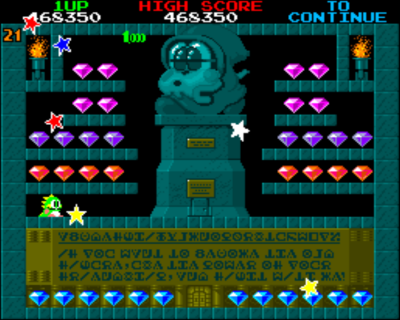
The first of three treasure rooms.
Further treasure room doors appear at levels 30 and 40 too - but it gets increasingly difficult to reach these without losing a life. The final secret door appears at level 50, which instead of leading to a treasure room warps the player forward by 20 levels, ever closer to the show-down at level 100.
There's fun to be had on the high score table too. Entering various names will cause unusual things to happen in the next game. For example, enter "SEX" as your name and the level 1 bonus in the next game will be a fork. Collect this and fruit falls from the sky, turning the enemies into diamonds. Similar effects are to be had entering names of "I.F", "KIM" and "...", as well as several others.
Many other secrets exist within the game, but you'll have to look them up yourself if you want to find out more - there are a number of good web pages to be found detailing the secrets of Bubble Bobble.
Cheats
Cheats? In an arcade game? That's a bit unusual isn't it? Well perhaps it is, but there are two cheats built into the game that will make it easier to play. These are activated from the title page when the main Bubble Bobble logo is displayed, before any money is inserted.
The first cheat gives the player the shoe bonus (fast movement) and the blue and yellow sweets (rapid fire and fast moving bubbles) at all times. This makes the game very much easier to play! To activate this, press the following key sequence:
Left, Jump, Left, 1Player, Left, Bubble, Left, 1Player
"Power Up!" will appear at the bottom of the screen if this has worked.
The second cheat gives access to all of the treasure rooms and the level warp on level 50, even if you've lost a life. To enter this, wait for the logo to come around again and enter the following key sequence:
Bubble, Jump, Bubble, Jump, Bubble, Jump, Right, 1Player
"Original Game" will appear. Both cheats can be activated at the same time in this way (wait for the title screen to come around again to activate the second cheat).
These cheats were like gold dust in the mid-80s, a time before the World Wide Web existed, and were jealously guarded secrets in playgrounds the world over!
One of these cheats also led to a long-standing rumour about some mysterious extra levels, levels 101 and 102. The reason for this is that the Original Game cheat makes it possible to lose your last life in a treasure room (normally this couldn't happen as you would have to be on your first life to access it). The treasure room was actually stored as room 102 in the game, and this would then appear on the "Today's Record" screen, misleading anyone that later spotted it.
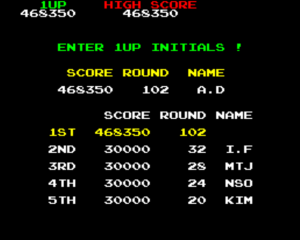
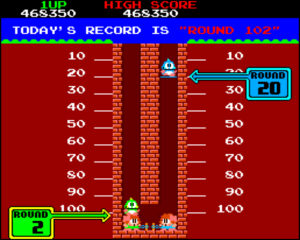
The mysterious (and non-existent) "extra levels."
Room 101 does actually exist too, but it's the room used in the attract mode to explain how to play. Both of these levels can actually be accessed by playing the game in M.A.M.E. and using a cheat code to set the starting level. There are no "real" additional levels to be found, though.
Finishing the game
Should be straightforward enough - just clear level 100? Well in fact there are a few different endings to this game.
If you clear level 100 in one-player mode, you'll be told that you didn't reach the "true ending", and warped back to a level somewhere between 50 and 80 to have another go. This is actually rather good as it means the game can be played forever (or until you finally run out of lives). A single credit can last a very long time if you get enough practice.
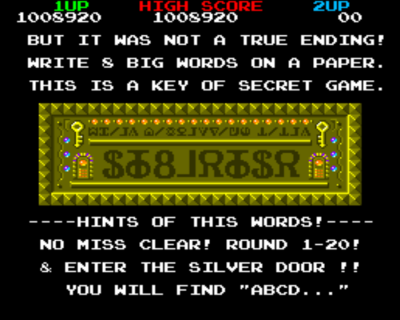
Not a true ending.
Clearing the game with two players alive at the end will display the "happy ending". Bub and Bob meet up with their girlfriends and presumably live happily ever after. But this is soon shown not to be the "true ending." A message appears (in rather confusing Engrish) telling you to "write 8 big words on a paper." After figuring out what the game is trying to tell you, you eventually find yet another code to be entered at the title screen.
Once this has been entered, the game enters "Super Bubble Bobble" mode, with a slightly different title-screen logo. Playing is now rather more difficult as all the enemies have swapped around. Finishing the game in Super mode with both players alive finally reveals the true ending to the game. Phew!
Computer and console conversions
Following its success in the arcades, Bubble Bobble was converted to a wide range of computer and console formats. These include the Apple II, Amiga, Atari ST, C64, Gameboy, MSX, NES, Sega Master System, Sega Saturn, PC, Playstation, Spectrum and more.
It won't come as a surprise to find that the quality of these conversions varied quite significantly, and few of them came close to the arcade original.
The first thing that obviously suffered in many of these versions is the graphics. The Spectrum version made a good effort with all the characters recognisable even if they are monochrome. The C64 version looked like the characters were all feeling a little unwell. The console versions tended to look a lot better than the 8-bit computer versions.
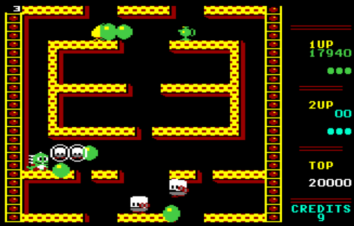
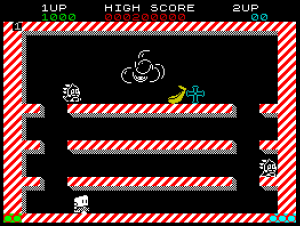
The Commodore 64 and Spectrum versions of the game.
Considering the number of things that the game needed to move on screen at once (there could be dozens of bubbles floating around at times) the computer versions actually deserve a fair amount of credit. Many of them had few (if any) hardware sprites, and so getting this amount of action to take place was quite an achievement.
Mention should also be made of the Gameboy version: an ambitious attempt that was let down a little by flickery graphics, but much more by the fact that the levels didn't fit in the tiny display. This resulted in scrolling levels, which made it much harder to work out where (or on what!) you were about to land.
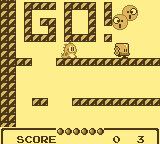
Bubble Bobble on the Gameboy.
Perhaps the best conversion was that for the Sega Master System. Not only did it look and sound very close to the real thing, but most of the more subtle game features survived intact too.
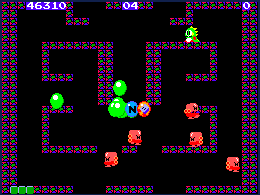
Sega Master System -- the best of the bunch?
Many of the secrets and obscure features of the arcade sadly didn't make it into the conversions though, and for the Bubble Bobble purist this is one of the things that makes the arcade version stand out from its imitators.
Modern versions
There have been several official Bubble Bobble releases over the last few years. The game was converted to many of the more recent consoles including the Sega Saturn and Sony Playstation.
A version was also produced for the Gameboy Advance, this time using the increased screen quality to fit the whole level on the display without having to scroll.
The most recent official version was part of the "Taito Memories" pack released for the Nokia N-Gage. This was included alongside new versions of Super Space Invaders and Qix.
Taito announced a few years back that they had actually lost the source code for the arcade version of Bubble Bobble. All of the recent versions were based on disassembly of the arcade ROM (which is always going to be difficult to read) and from the earlier computer and console conversions.
There have also been many remakes of the game, usually including new levels and updated graphics (and unfortunately usually with a price-tag attached as the majority of them are shareware). One of the better known of these is "Bubble Bobble Nostalgie" (http://www.alawar.com). This version features colourful graphics and both new and familiar levels.
A whole range of similar variations of the game is available from http://www.bubble-bobble-games.com. Many of these appear to be the same game engine with different levels and graphics, though.
Bringing the game into the Internet era is The Bub's Brothers (http://bub-n-bros.sourceforge.net). This is a multiplayer version of the game with a maximum of ten players at once - sounds like mayhem!
And finally perhaps the most unusual remake currently in development is a new version for the Atari 800 console. More details here: http://www.atariage.com/forums/viewtopic.php?t=52701.
The Bubble Bobble Time-Line
The characters from the game have actually appeared in a whole series of arcade releases - here's the rundown:
Chack'n Pop (1983). A rather bizarre platform game. This doesn't feature Bub or Bob, but several of the other monsters from Bubble Bobble appear here.
Bubble Bobble (1986). The debut outing of Bub and Bob.
Rainbow Islands (1987). Bub and Bob return, in human form this time, in a new vertically-scrolling platform game. Taking full advantage of the advances in graphics hardware, this is a very colourful game, full of the cute touches that have become a hallmark of the series. Bub and Bob can create rainbows, which they can climb across or knock onto the heads of their enemies to kill them. The game is split over a number of islands, one of which ("Bubble Island") features all the bad guys (and some of the levels) from the original.
Parasol Stars (1992). The next instalment appeared on a variety of computers and consoles but strangely does not appear to have made it into the arcades - a pity, as it's a great game. This time Bub and Bob (still in human form) are armed with parasols with which they can attack their opponents. They can also capture enemies or bubbles (containing fire, water or lightning) on the tops of their parasols, which can then be fired at the bad guys for extra points.
Bubble Symphony (1994). A return to the original game formula but with a much more modern feel. A selection of playable characters with different skills, branching level structures and (thank goodness) a continue option all feature, yet this looks and feels fairly similar to the original game.
This time we see Bub and Bob's four children, Little Bubby, Little Bobby, Kululun and Cororon, transformed into bubble blowing dragons by the bad guys in revenge for their parents' actions in the original game.
Puzzle Bobble/Bust-a-Move (1994). In what must be one of the most copied games ever created, Bub and Bob leave the platform world for a fun and original puzzle game. Bubbles must be fired into a playfield to form groups of three or more of the same coloured bubble, at which point they disappear. Simple and very addictive!
The bubbles, of course, all contain creatures from the original Bubble Bobble. Bub and Bob do little more than aim the bubble machines, however.
Puzzle Bobble spawned an entire series of games in its own right, each one building on the previous games. The basic formula is still unchanged from this version, however.
Bubble Memories (1995). The last of the platform games in the series, this plays like Bubble Bobble on steroids! The same game play is present as the original, but this time huge bubbles can be blown into which multiple enemies can be captured at once - which is just as well as there are some huge enemies now too.
Instead of working downwards, the game progresses upwards this time to the top of the Rainbow Tower, and "boss" enemies appear every few levels along the way. 160 rounds of chaos separate you from victory!
This article is copyright © Adam Dawes,
2004.
It may not be copied or redistributed without my express written
permission.